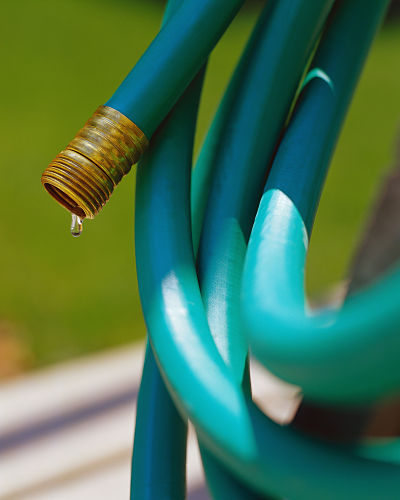Watering Tips & Instructions
 Water is a vital part of maintaining your landscape and the plants it contains. Mother nature is kind enough to assist in this process, but your help is needed as well. Even though many plants are drought resistant and can remain dormant in a drought, most plants will die without occasional water. Below, we have provided some useful information on how to help your keep your plants healthy and thrive.
Water is a vital part of maintaining your landscape and the plants it contains. Mother nature is kind enough to assist in this process, but your help is needed as well. Even though many plants are drought resistant and can remain dormant in a drought, most plants will die without occasional water. Below, we have provided some useful information on how to help your keep your plants healthy and thrive.
New Plantings
All watering times suggested in this page are dependant upon water preasure, location of the plant, and size of the plants. Please use this as a guide, not specific instructions for your particular landscape.
Annuals: Annuals are the most water dependant plantings in your landscape, they can require water far more often than other types of plantings. Water your annuals on an every other day basis to start, adjusting for temperature increases or drought conditions. If you see your annuals leaves start to wither, water imediatly. A thourogh soaking should be your goal each watering.
Perennials: All perennials must be watered two times per week for 20-25 minutes per bed for the first six weeks. If more than 1/2 inch of rain occurs, no water is required for that half of the week. If watering is not done there could be plants that perish or show a reduced rate of growth. Plants that are under watered will start to wilt or discolor.
Shrubs: The shrubs and trees will require watering twice per week for 3-5 minutes per plant. This watering should saturate the ground around the plants root ball but not cause standing water to form for more than 30 seconds. The plants should be watered for the first 3 months, with watering times increased by 25% in the heat of July and August.
Sod & Seed: All sod/seed must be watered daily for 5-10 minutes per area or until the ground is saturated, for the first two weeks. After the first two weeks, sod/seed needs to be watered three times per week for the next six weeks. If more than 1/2 inch of rain occurs, no water is required for that half of the week. If watering is not done there could be sections of the sod/seed that perish or show a reduced rate of growth. Look for underwatering, sod/seed that is underwatered will start to wilt or discolor quickly.
Trees: Trees are a special case, being larger plants and slower to recover from transplant shock. Watering new trees depends upon several factors: species of tree, soil type, exposure, and available soil surface area of the planting site are just a few things to be considered. At a minimum, water your new trees twice a week with a slow, saturating soak from a garden hose. The key idea with tree watering is to keep the top 8"-12" of the soil moist. A good method of checking the soil around the root ball for moisture is digging a small hole in the soil backfill next to the root ball about 6" deep. Feel the soil from the bottom of the hole for moisture, if it's wet don't water the tree that day. Fill in the hole after checking.
The tender, fibrous roots that these plants produce are in need of continuous moisture until established in the new locations. The main requirement of most plants is water, even more so than nutrients. In most cases a minor change in watering timing or duration can be the difference in a plant surviving or not.
Lawn Watering
The general rule of thumb is that most grass requires 1 inch of water per week. Research has shown that proper mowing and fertilizing practices encourage a deeply rooted, healthy lawn that efficiently uses its water supply. However, a lawn may need more water if it is under stress from foot traffic, insects or other environmental factors. Divide your watering into a twice per week schedule. It is better to water infrequently and heavy as compared to more frequently and light.
Water as infrequently as possible.
Water no more than three times per week under drought/dry periods and two times per week during regular conditions. Thoroughly water, when you do water so moisture soaks down to the roots. Deeper roots draw moisture from a larger volume of soil and therefore require less supplemental irrigation. Taller grass has deeper roots and a lower tendency to wilt. Exceptions to this general rule would be for newly seeded lawns where the surface needs to stay moist, newly sodded lawns that have not yet rooted into the soil, or when summer patch disease is a problem. Otherwise, avoid frequent waterings that promote shallower root systems and lawn weeds.
Knowing when to water
Early morning, between 4 a.m. and 9 a.m., is the best time of the day to water. Winds are minimal, the sun is not intense and the water is less likely to evaporate. Watering early in the day also reduces the amount of time that standing water is on the grass, reducing the chances for lawn disease. Early or late in the day reduces the amount of evaporation that takes place during the very hot day, allowing more water to reach the root zone. Purple-blue wilting leaves, footprints that stay, and folded or rolled leaves are signs that lawns should be thoroughly watered if grasses are to remain green and actively growing.
Uniform Irrigation.
Sprinklers can water the lawn in different patterns, depending upon the head type, but all heads require spray overlap for uniform coverage. Placing tuna cans or similar straight-sided containers on the lawn can help measure how much water your lawn is receiving in a particular area. Avoid flooding areas, causing run-off, or missing areas. On heavy clay soils and slopes, watch for excessive runoff; it may be necessary to water several times to allow for adequate penetration into the soil.
Surviving Drought Conditions
In periods of high temperature and reduced rainfall, and to help conserve water, mow your bluegrass lawn at a higher than normal height (3" would be fine), limit traffic over the lawn, and soil compaction. During extended periods of summer drought, dormant lawns (browned-out leaves) containing Kentucky bluegrass, tall fescue or perennial ryegrass should receive 1.5 inches of irrigation every two weeks to maintain hydrated grass crowns and allow for full lawn recovery when more favorable moisture and temperature return in the fall. The biggest factor in why lawns fail during extended dry spells, is that they weren't healthy going into the drought. Therefore, you need to do everything you can to make your lawn as healthy as possible when conditions are good for growing lawns. Part of Suburban Landscaping’s lawn care program is developing strong, healthy turf grass that can withstand periodic extreme conditions.
Other Tips
Taller grass provides shading of the soil surface and reduces temperatures near the base of grass plants. Lawns mowed weekly at a taller mowing height are less likely to be scalped, causing loss of lawn density. 3" mwoing height is recommended during times of high heat for all bluegrass lawns.
Lawn Diseases
Dollar Spot: The small circular patches you see in your turf are not because the lawn is dry, it is because of a lawn disease called Dollar Spot. Ifyou see this situation, do not increase the water settings of your sprinkler systems. The additional water that is applied is causing the spread of the disease, it is not the cure for the disease. Refrain from using your sprinkler system other than the times suggested above.


